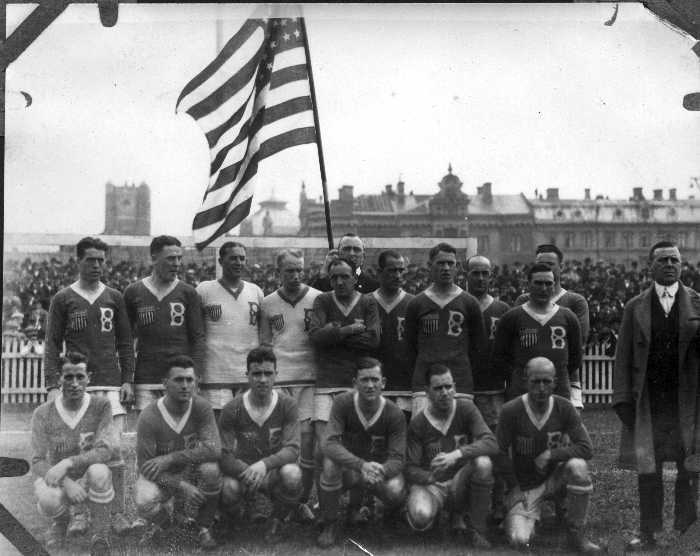
Against the expectation of many in the US, the United States Football Association’s first international tour in Scandinavia in the summer of 1916 had been a great success. The cash-strapped USFA had come out of the trip in the black — the Swedish FA had paid for the tour thanks to the backing of a leading Swedish newspaper — and the team had performed well to garner a 3–1–2 record despite having been put together only days before departure to Europe without the benefit of tryouts. Plans for more Scandinavian tours — notably of the St. Louis club the Ben Millers — would be cancelled, however, when the US entered the First World War in April 1917.
With the Armistice of November 1918, plans to return to Scandinavia were renewed. In the summer of 1919, Bethlehem Steel, for the second year in a row holder of both the National Challenge Cup and the AFA’s American Cup, became the first US club team to embark on an overseas tour.
Prelude
When the USFA agreed to the 1916 Scandinavian tour, Bethlehem Steel was the logical choice to represent the association, having become in the spring of 1916 the first team to win both the National Challenge Cup and the American Cup. At least this was true in terms of representing the association as the best club team in the United States. As a US national team, Bethlehem would not work — the majority of its players were British citizens.
If this presented a conflict for the USFA it was rendered moot when, despite the offer of a handsome guarantee to offset the costs of the tour, the club’s owners reasoned that the danger of submarine attack during the Atlantic crossing was too great, even with the protection afforded by making the passage on the neutral ships of the Swedish-American Line. Nevertheless, two Bethlehem Steel players, right halfback Thomas Murray and center halfback Neil G. Clarke, were included on the US roster, as were three players from Philadelphia teams: C.H. “Dick” Spalding, a left fullback with Tacony’s Disston AA team, co-champions that year with Bethlehem of the city’s American League; left halfback Albert Blakey of the city’s Allied American League champions, Putnam FC; and Walter Bergin, inside left for Philadelphia Wanderers, also in the Allied League.
Bethlehem’s first international trip
Bethlehem did make an international trip during the war. After defeating an All-Canada team 4–1 on November 17, 1918 in Harrison, New Jersey in an exhibition match to benefit the United War Work Fund, the team traveled to Toronto for a rematch at the University of Toronto’s “Varsity Stadium,” whose pitch was described in the November 25 edition of the Bethlehem Globe as being “as level as a billiard table and the grass like a bowling green.” However, when Bethlehem played the All-Canada eleven on a snowy December 1, “the splendid field of the Toronto University was covered to the depth of several inches, and the footing was rendered very treacherous and unadapted to a good display of football.” Nevertheless, Bethlehem emerged the 2–0 winners in front of some ten thousand spectators in a game that the December 2 match report in the Globe described as “fraught with excitement from the start.”
At the end of December, Bethlehem traveled to St. Louis for a series of three games, winning the first game before suffering their first draw and loss of the 1918-19 season.
Possibilities of tours in England, Scandinavia, and Brazil
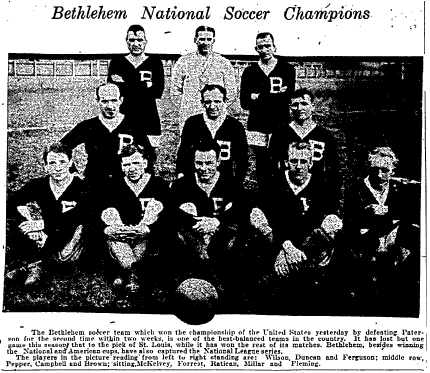
Bethlehem had clinched the National Association Football League championship by the first weekend of March 1919. On March 17, the Globe reported rumors that, should Bethlehem win the National Challenge Cup and the American Cup, “negotiations would be opened for a series of exhibition games in London.”
On April 10, the Globe reported that the winner of the National Challenge Cup would be chosen to tour Scandinavia. Bethlehem defeated Patterson FC 2–0 in the National Challenge Cup final at Fall River, Massachusetts on April 19. The Globe reported on April 22, “Thomas W. Cahill, secretary of the United States Football Association, announced immediately after the game that in recognition of the remarkable record compiled during the season by the team it was definitely arranged that the Steel Workers tour Norway, Sweden and Denmark for a series of exhibition games.” Lest there was any doubt that Bethlehem was the best team in the United States, on April 26 they again defeated Patterson 2–0, this time in the American Cup final, played at Disston Baseball Park in the Tacony section of Philadelphia.
On April 28, the Philadelphia Inquirer wrote of the team’s accomplishments, “Speaking of Bethlehem, you certainly have got to hand it to the players for the manner in which they keep in the game. What is more, they have more soccer in their think tanks than the average player, while they are also there with the combination stuff.”
On May 10, the Globe reported that the trip to Scandinavia was now in doubt: “While it is believed that Swedish promoters are keen for the exhibition contests and that the champions would be a big drawing card, it is hinted that the guarantees offered do not quite suit or warrant making the trip.”
Meanwhile, the team prepared for another trip to Canada. An update on the Scandinavian tour on May 14 noted that “at the same time the American aggregation is touring Sweden, the Chelsea and Tottenham Hotspur teams of England will also be there… and negotiations at present are on with the English team for a game each to be played either at Stockholm or Christiana [present day Oslo].” On May 17, the Globe reported the USFA had voted to authorize the Scandinavian tour. After Bethlehem defeated all-star teams in Toronto, Niagara Falls, and Hamilton, the Globe reported on May 29 that Cahill had completed all arrangements for the team to travel to Scandinavia.
On June 2 the Globe reported that Bethlehem manager William “Billy” Sheridan had accepted an offer from the Brazilian FA for the team to play a series of exhibition games in that country if the games could be scheduled for after the Scandinavian tour. The Globe wrote, “When challenges are received from different parts of the world for international soccer clashes with the United States champions it fully indicates the widespread fame established by the team. The fact that the Bethlehem team has won the national honors for the past four years and that the last season has been the “greatest ever” since the club was established, has placed the team in great demand.”
A Globe report on July 17 providing details of the team’s Scandinavian dates included an update on the Brazil tour plans, saying “the team will play a six-game series in Rio de Janeiro, Sao Paulo and Santos, Brazil, under the auspices of the Brazilian Federation of Sports. The terms of the Brazilian organization have been accepted, but no dates have been announced. The United States champions may meet in Brazil the famous Fluminense Club, which recently won the championship of South America in a series in which Argentina and Chile were strong competitors.”
The tour roster
Cahill, who would be acting as the general manager of the tour with Sheridan as “the trainer,” announced the roster for the Scandinavian tour on July 15, 1919. Six of the 17 players on the roster were guest players, including four players who had been part of the 1916 All-American tour of Scandinavia. Among them was Philadelphia’s Albert Blakey, who had just returned from army service. Bethlehem’s Thomas Murray, himself just returned from military service and a member of the 1916 tour, was also on the roster. Roger Allaway writes in Corner Offices & Corner Kicks that the inclusion of Archie Stark and Davey Brown from the Patterson team “enabled Bethlehem Steel to field a forward line twice in the 14-game tour that included four future Hall of Famers, Stark, Brown, Harry Ratican and Whitey Fleming. That may have been the most powerful group of forwards ever to play for the same club team in American soccer history.”
Ratican, the St. Louis native who had joined Bethlehem in 1916, had announced before the tour that he would be leaving the club. Nevertheless, the Globe reported on July 21 that he would be the captain of the team. (Later reports suggest that James Campbell and Fred Pepper variously served as captain.) The Globe noted, “It is hoped that during the trip the influences of being in personal contact with the players throughout the trip will induce him to change his plans in seeking quarters other than Bethlehem in plying his soccer ability next season.”
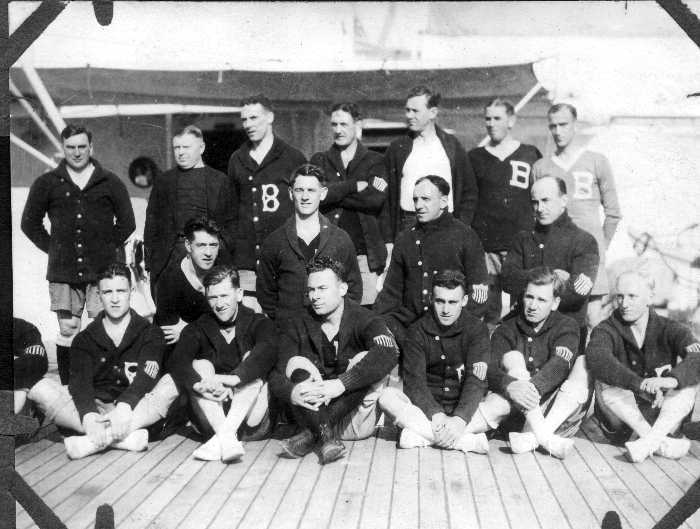
That night a banquet was held in the team’s honor before their departure from Bethlehem the next day for New York. The Globe reported on July 22 that two Bethlehem players who had initially been left off of the roster, Jimmy Easton and Bobby Morrison, had been told they could join the tour.
The contract for the games called for so many men, and for this reason, it was explained that Easton, whose playing on the Bethlehem team has always been appreciated, was omitted. During the banquet one of the men fostering the sport spirited Easton and Morrison to a quiet corner and from there, after a brief confab, both players emerged smiling and joining in the celebration with a heartier enthusiasm. It was then learned that these two men will probably sail as soon as their passports are secured. The teammates of both and followers of the game will be glad to hear that they are to be included on the trip.
In the event, neither player joined the team in Europe.
Just before boarding the train to New York, one of the “optimistic soccerites” among the “crowd of happy athletes” remarked, “I am not going to tear loose until that old boat sets sail and then I know nothing can happen to cancel the trip.” Sheridan told the Globe, “They are not going to a good time going over. But after we leave South America, homeward bound, it will be different; the serious work will be over by that time.”
Training aboard the Swedish-American liner Stockholm was rigorous. Sheridan said at the farewell banquet, “You know there has been little playing since our last invasion into Canada and it is only natural that the players are somewhat out of condition. The boat is big enough to carry on training en route and there are sure to be some strenuous sessions of rope jumping, bouncing around the medicine ball, lengthy sprints and many other forms of training.” But, the players would be traveling in style. In addition to first-class accommodations, the Philadelphia Inquirer reported on July 22,
Steamer and equipment trunks of the tourists, who will be 21 in number, will be labeled with a unique poster in five colors, lettered at the top “Scandinavia Tour.” On one side of the space reserved for the name of the owner of the baggage appears a likeness of a Bethlehem player, correctly attired in the Steelmakers’ light blue and white, interlaid with the national colors of Sweden, Norway, Denmark and the United States. Beneath, in inline lettering, appears the Bethlehem club record: “Bethlehem Steel Co. Soccer Football Club: Champions, United States; 1914-15, 1915-16; 1915-16; 1917-18; 1918-19.”
If expectations had been low before the All-American tour of Scandinavia in 1916, the opposite was true for Bethlehem Steel. On July 25, the Inquirer wrote, “If America’s championship socker football club, Bethlehem’s Steel Company’s great team, fails in its conquest on foreign fields in the next three months, it will have no excuses to offer.”
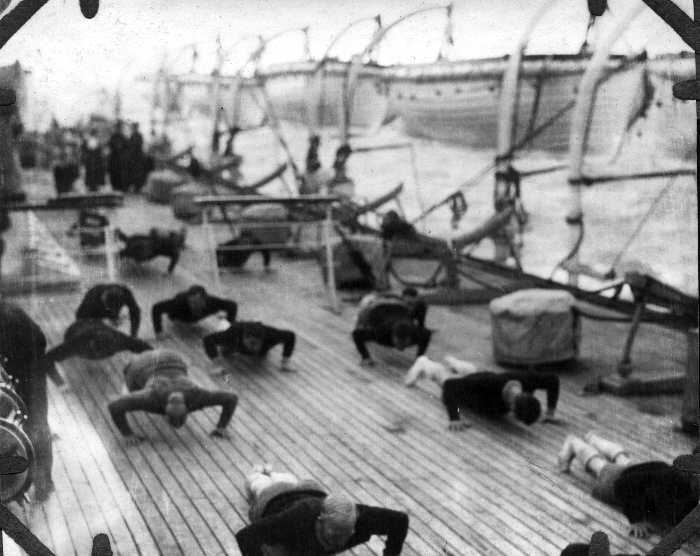
In Scandinavia
Departing US shores on July 23, the team landed in Gothenburg on August 4. After a week of training, Bethlehem faced its first opponent, AIK, on August 10 in a match that ended in a 2-2 draw. An Associated Press report printed in the August 11 edition of the Inquirer read, “A large crowd of spectators witnessed the game, which aroused much enthusiasm.” On September 9, the Globe printed a translation of a Swedish newspaper account of the match, which noted that Stockholm’s Olympic Stadium was filled to its 20,000 seat capacity “with several thousand outside,” some of whom “bid as high as 100 Kr. for a ticket [about $235 in current value if my calculations are correct], but could not get a seller, which shows that there is still money in old Sweden, and it also shows that the interest in football is still higher, and also that the Stadium is sometimes too small.”
The Swedish account continues,
The Bethlehem players could not find themselves in this first match…Bethlehem Steel Company, America’s best team, played an undecided game, 2 to 2, against AIK It might as well be said that the team from Stockholm played a better game than was expected. Such a game—to use the players’ own words—the AIK has not played since the day when the Liverpool team visited Stockholm. Now to the game. Some people say that they were disappointed in the American team. Why? Because they did not beat the AIK. It is true that they, in this their first match in Stockholm did not play the Scotch play that was expected from them. The forward line did not hold together very well, and the halfbacks did not follow properly when they were pressed the hardest by the AIK. These combinations did sometimes not succeed and especially Ratican, the center, was for the day, indisposed. The speed was just the same, greater than what had been seen in [Stockholm] Stadium for many a day. Add to this that the Americans played their first match in a foreign country on a practically strange field and before a foreign crowd and for their own local team, partisan public. They were during the first half period nervous and this nervousness did not disappear during the second.
The report noted that Fleming, Bethlehem’s left forward, “made the best impression on the public,” and that “The Bethlehem players were distinguished for their good headplay.”
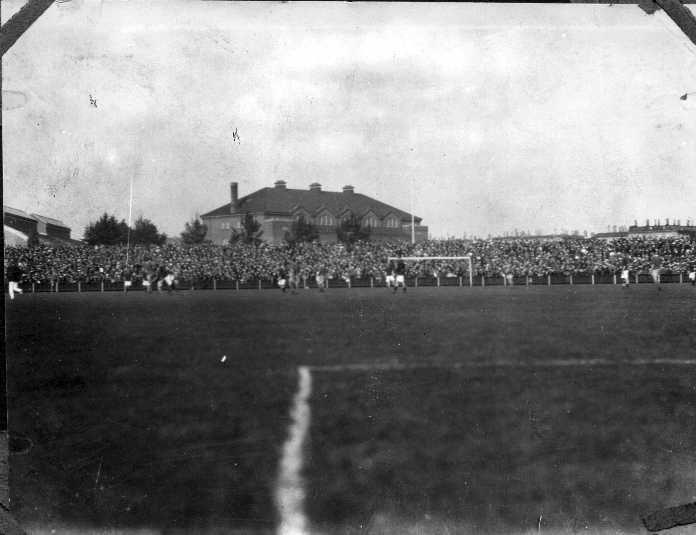
On August 14, Bethlehem defeated Stockholm Tigrara 1–0. A report the next day in the Globe said, “With one victory and one tie game to their credit, the champions will no doubt enter the following contests chuck full of confidence which should prove a big asset in their playing. Forestalling defeat in the opening two contests is a wonderful achievement.” The same day, the Philadelphia Inquirer reported that Albert Blakey, the Philadelphia player who made his first start of the Scandinavian tour in the win, would be joining the new Hardwick & Magee factory team in the city’s Industrial League.
A translation of a Swedish newspaper account of Bethlehem’s win appeared in the September 10 edition of the Globe. The account noted that the first match had set an attendance record for the Stockholm Stadium and that the second match, taking place on a Wednesday, set an “audience record for an every-day evening” with more than 15,000 on hand. The report said of the play, “Characteristic for Wednesday’s game was speed and force. And what else could it be when Americans appear on the field?” The report said of the play of Blakey and Thomas Murray, teammates on the 1916 tour, “Murray and Blakey in outer halfback played the entire match with furious speed…One enjoyed the hard and quick way to go ahead, which these gentlemen displayed. Not a moment was left for the Tiger chain to consider the situation.”
On August 17, the team faced a select Swedish Provinces team in Stockholm, winning 2–1. The Globe triumphantly reported on August 18,
Bethlehem now has a good sized edge on the foreigners and it would appear from the showing of the Steel Workers to date that they will return with the greatest honors ever garnered by an American soccer eleven in the history of the game in this country. Also that a victory in this international series in a sport that is really still in its infancy in this country is another high tribute to the standard of athletics developed in America. The Bethlehem Steel team has won all the honors possible in the United States and to add to its glowing record was forced to invade foreign shores for still more glory. Prophets, who from time to time last season could not fully reconcile themselves to the fact that the team sporting the Bethlehem colors was the peer of all other soccer aggregations in the country and contributed many of the victories to games played on home grounds or some other ridiculous reason, are awakening to the fact that their contentions were all wrong and that the champions possess the ability to carry on their victorious stride on foreign soil as well as at home.
On September 15, the Globe printed an assessment of the team’s performance through its first three games: “Whatever the outcome is of the remaining games in the Scandinavian tour of the Bethlehem Steel Workers, they will return home with the laurels of ranking with the greatest soccer elevens in Scotland and England. This is foreseen in the opinion of Harry McGregor, of the Scottish League, who witnessed three of the games abroad, and says the home teams are on a par with the leading clubs of Scotland and England.”
The team followed their second victory with a 1–1 draw with Djurgardens on August 19. Bethlehem played their first match out of Stockholm, a 1–1 draw with Norrkoping, on August 24. On August 26, the team chalked up another win with a dominating 4–0 performance over an All-Skane team at Helsinburg. Allaway writes that the win in Helsinburg was perhaps their best performance on the tour and “was one of the two in which Bethlehem fielded its most star-studded set of forwards.”
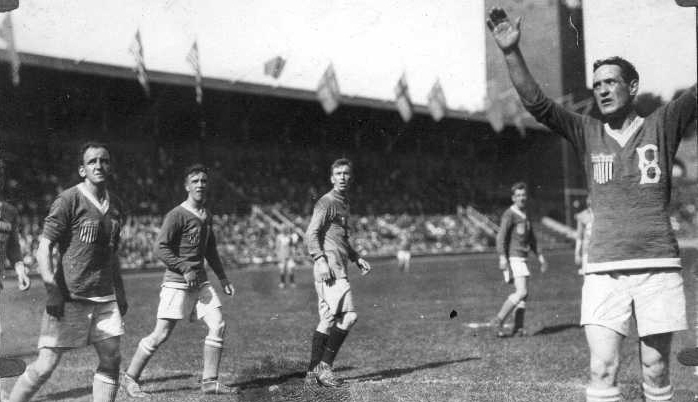
Bethlehem next traveled to Copenhagen in Denmark where they drew 1–1 with Boldklubben af 1893 on August 29. On September 4, the team suffered its first loss of the tour, falling 3–2 to an All-Malmo team. The Globe reported on September 5, “A cablegram received at the offices of the Bethlehem Steel Company states that the players were tired after a long trip from Copenhagen.” The report continued,
The defeat by no means lowers the colors of the American aggregation, who in the games played thus far have a strong hold on the international honors and rather than disgraced by their defeat, adds even greater laurels by virtue of their previous victories. The score, as in all previous games, would indicate that the Americans went down to defeat only after a brilliant fight and forced the opponents to their utmost to gain the one-goal advantage.
Three days after their defeat in Malmo, Bethlehem suffered its second and final loss of the tour, falling to Goteborg Kamraterna in Gothenburg. The Globe reported on September 8 that a cable received at the offices of the Bethlehem Steel Company read “Gottenberg 3, Bethlehem 1. Good game. Unlucky.”
Bethlehem never looked back after that second loss, going on a four-game winning streak. On September 10, they defeated Goteborg Orgryte 1–0, the team with which an All-American victory in 1916 had been followed by local supporters attacking US players and officials. On September 14, Bethlehem redressed their earlier 1–1 draw with Norrkoping by defeating them 2–0. On September 18 they returned to Stockholm to defeat an All-Stockholm team 1–0. On September 21 they defeated an All-Sweden side 3–2 in Stockholm. For the last game of the tour, Bethlehem played Hammarby to a scoreless draw.
Bethlehem finished the Scandinavian tour with a 7–2–5 record, outscoring their opponents 22–14. The two highest goal scorers, John “Rabbit” Hemingsley (8), a veteran of the 1916 All-American team and with Philadelphia Merchant Ship in the 1918-19 season, and William Forrest (5), were guest players.
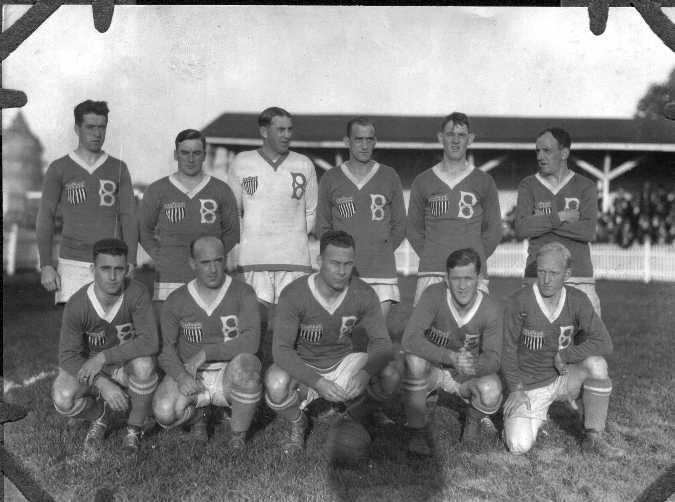
The return
The team left Bergen for the US aboard the Norwegian-American Line steamer Stavansgerfjord on September 27. They were preceded by Jimmy Easton and James Wilson, who arrived back in the States aboard the Cunard Line ship Caramania on October 3. The two players had included a three-week stop in England and Scotland to visit relatives. (Given that the passage from Britain to the US would have taken at least ten days, combined with the length of their visit to relatives in England and Scotland, Easton and Wilson could not have been available to play many of the Scandinavian fixtures.)
On October 4, the Globe reported that half a dozen of the returning players, as well as Bethlehem Steel team manager William Sheridan, would also be spending time in Britain before their expected return to the States on October 28. On October 7, the main party of players arrived back in Bethlehem, “Looking fit as a fiddle and ready to assume responsibilities in the American soccer campaign this year.”
The team’s commencement of National League play for the 1919-20 season was delayed while it awaited the return of the players who were visiting with relatives in Britain. On October 14, the Globe confirmed that Ratican had signed with Robins Dry Dock in Brooklyn, where he would join Bob Millar and Neil Clarke, who had also left the Steel Workers following the end of the 1918-19 season before the start of the tour. The Globe reported, “Ratican refused to comment on the reason for his desiring a change of scene but it is believed that his action was prompted by friction with some of the players. It is understood that for some time he has not been getting along any too well with certain members of the team and toward the close of last season had already announced his intention of leaving.” The Globe had reported throughout the tour that there was hope that several of the guest players would join the Bethlehem roster on a permanent basis after the tour but none did. Archie Stark did later join Bethlehem in 1924, playing with the team until 1930.
Pressure from other teams over Bethlehem’s delayed start of league play continued to grow. On October 23, the Globe published a report that described how league officials had “severely criticized” dissension from other teams.
Rumors had it that Bethlehem Steel F. C. has received a greater amount of leeway than any other club would have received had it gone abroad as Bethlehem did during the latter part of the summer. The officials of the National League at their meeting made it pretty clear that Bethlehem had permission to make the trip and was advised as far back as June that their schedule would be delayed until they arrived home. With this perfect understanding before the final arrangements were made for the tour, there is no cause for the attitude apparent among other clubs.
In the meanwhile, the club organized exhibition matches and began American Cup and National Challenge Cup play. Bethlehem would not play its first National League match until December 6, by which time other teams in the league had already played as many as seven games. After losing two of their first three games the team turned things going on to win their last eight games to finish as league champions by one point.
Things did not go so well in Cup play. After a 10–0 fourth-round win over Philadelphia Wanderers in the National Challenge Cup, Bethlehem was knocked out of the semifinals with a 1–0 loss to Robins Dry Dock, the team to which former Bethlehem players Ratican, Millar and Clarke had decamped. On May 9, 1920, the Ben Millers, the St. Louis team Bethlehem had played in 1916 and 1917, became the first non-East Coast team to win the National Challenge Cup. By then, Bethlehem had already tasted defeat in the American Cup. While victorious from the Round of 16 through to the semifinals by an aggregate score of 14–1, they lost the final to Robins Dry Dock on an own-goal on May 2, 1920.
What happened to the Brazil tour?
Newspaper paper accounts of the day are filled with mentions of planned tours that more often than not did not come into being for reasons that were often not reported. In the event, early mention by the Bethlehem Globe of possible games in England or with English teams in Scandinavia came to naught. Similarly, plans for games in Norway and Finland during the Scandinavian tour did not materialize.
In a report on July 7, 1920, announcing plans for a new Brazilian tour in the summer of 1920, the Globe explained that the original 1919 tour had not so much been cancelled so much as postponed.
In fact, the players left Bethlehem [in 1919] assured that they would tour South America and were somewhat disappointed when a cablegram reached them on board ship while en route to the Scandinavian countries calling it off. With an extensive schedule to be played in Sweden and Denmark, it was deemed unwise to make the final leg of the trip until this year. The decision was a wise one for it is remembered that the season in this country was well started before the Bethlehem players returned and in the opening games the men did not display their usual form. It is understood that several new men are expected to join the squad and that they will be included among the players on the trip.
On July 21, 1920, the Globe reported that the offer for another Brazilian tour had been accepted. “While it was known definitely that the trip was to be made,” the report said, “the details attending the tour were unknown pending the receipt of the cablegram announcing more definitely when the first game is to be played and the number of games scheduled.” On July 29, the Globe reported that William Sheridan had traveled to New York to discuss the details of the tour with Thomas Cahill. The Globe wrote, “Gathered from the conversation handed out by Sheridan before his departure the more important details have already been attended to and it is merely to check up on the data that he is paying a visit to Gotham.” The Globe then announced on August 3 that Bethlehem’s players had been ordered to report for training on August 5 in preparation trials to decide the roster for the tour.
On August 13, the Globe reported that “Sixteen players in charge of manager William Sheridan will board the Vistris of the Munson Line [actually the S.S. Vestris of the Lamport and Holt Line] tomorrow and set sail for Brazil.” The report continued,
According to reports received from Brazil, soccer enthusiasts in that country are eagerly awaiting the arrival of the Americans. The sport to Brazilians is what baseball is to Americans so that local fans can about imagine what a furor the impending international games has created among the sporting public. Their visit, in comparison, is looked up to as similar to what it would be in this country if England sent a baseball team over here to compete with the World’s champions. Then again the Bethlehem Steel Corp. have vast interests in South America so that the team will not be entirely unknown or without a fair quota of rooters.
But it was not to be. On Monday, August 16, the Globe reported that the players had returned to Bethlehem, the tour canceled. “According to one of the players the announcement canceling the trip came like a bolt out of the clear sky and keen disappointment was felt by all the men. The word from the local plant reached the players shortly before they were about to board the steamship Viatria [sic] to carry them to their destination.”
Edgar Lewis, the former Bethlehem Steel player and now company officer who also oversaw the team, explained the reason for the cancellation. “We were invited to play the series of games by the Brazilian government” he said, “but last Friday received a cablegram announcing that they decided to withdraw the invitation. We were given to understand that the reason for this action was in order to limit the competition to native clubs only. There is a possibility that they may change their decision and renew the invitation.” Allaway speculates, “The fact that Bethlehem was no longer the champion of either cup may have influenced the Brazilian government’s thinking” in canceling the tour.
Whatever the case, the year 1919 — with league, National Challenge Cup, and American Cup titles, as well as two successful trips abroad, one of which was the first-ever by a US club team overseas — would prove to be the pinnacle of Bethlehem Steel FC’s success.
A version of this article first appeared at the Philly Soccer page on January 4, 2012.
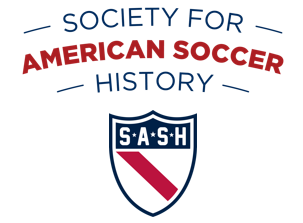
Pingback: 1918/1919 National Challenge Cup Semifinals & Final: Bethlehem Steel earn back-to-back shutouts to win 4th title | TheCup.us - Full Coverage of US Open Cup Soccer
Pingback: All-Scots in Bethlehem and Philadelphia, 1921 – Society for American Soccer History
Pingback: Footage from the Fall River Marksmen’s 1930 Central European tour – Society for American Soccer History
Pingback: Behind the footage: BSFC plays AIK and a select Swedish Provinces team in 1919 – Society for American Soccer History
Pingback: St. Louis Soccer Club tour of Sweden, 1920 – Society for American Soccer History